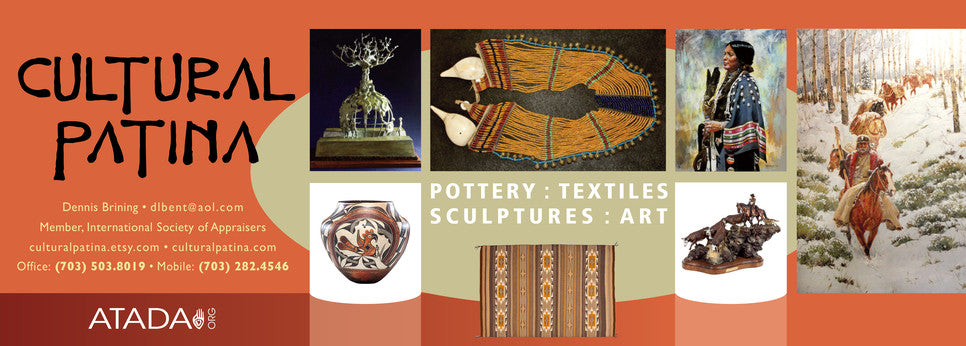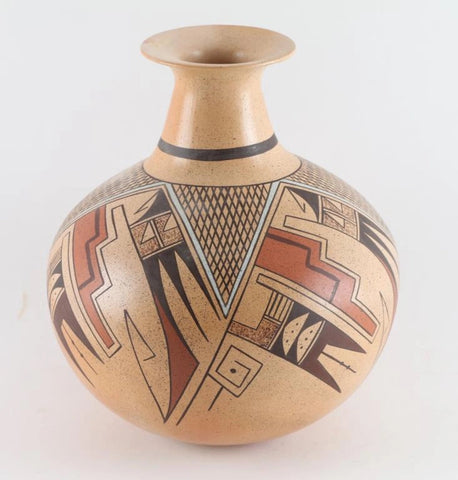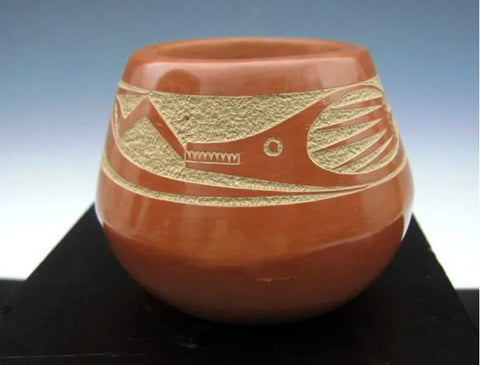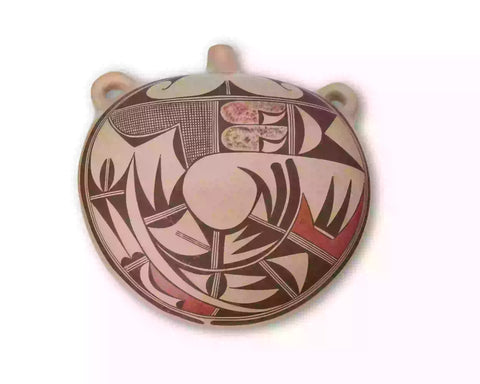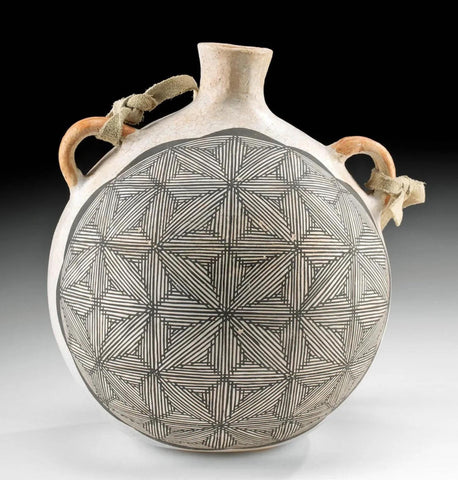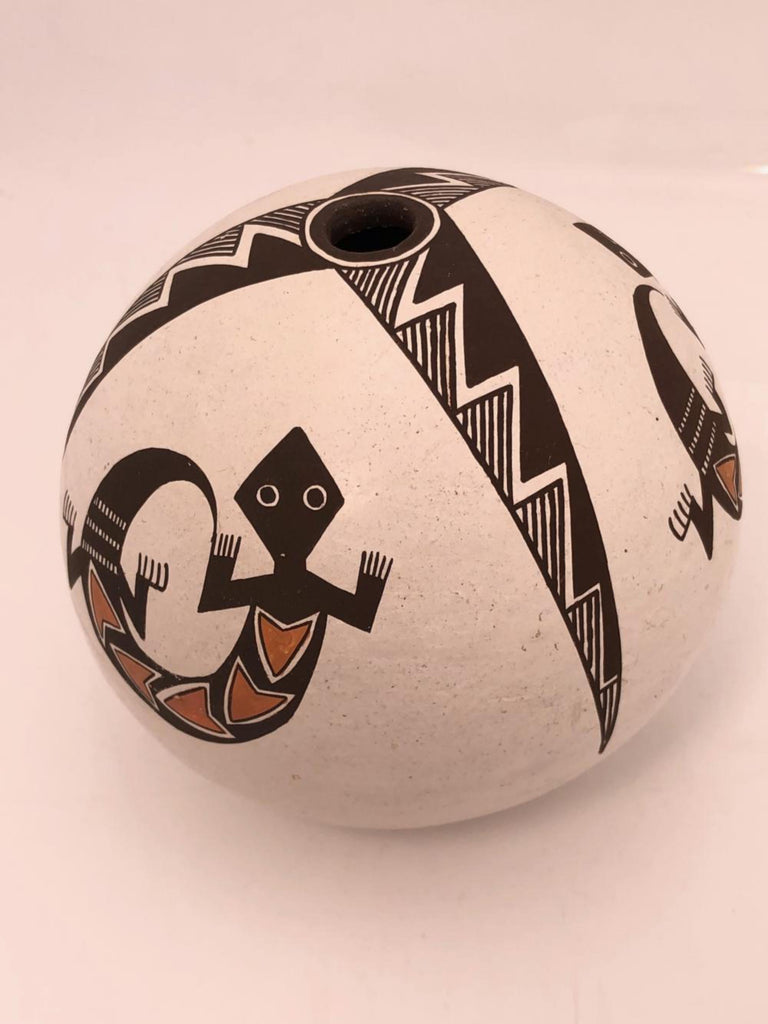
Native American, Vintage Acoma Poly Chrome Seed Jar, by Emma Lewis, Ca 1980's, #1505 SOLD
$ 500.00
Native American, Vintage Acoma Poly Chrome Seed Jar, by Emma Lewis, Ca 1980's, #1505
Description: #1505 Native American, Vintage Acoma Poly Chrome Seed Jar, by Emma Lewis, Ca 1980's, Acoma pot depicting lizards. Signed.
Dimensions: Height: approx 5" Width: approx 4 1/2"
Condition: Very good for age
Emma Lewis Mitchell (1931-2013) came from a family of potters whose mother was the 20th century potter Lucy Lewis of Acoma Pueblo. Emma and her sisters Ann Lewis Hansen, Mary Lewis Garcia, Dolores Lewis Garcia and Carmel Lewis Haskaya are all outstanding potters. Emma was born in 1931 at Acoma Pueblo. Her list of awards and honors is too long to include here. She has conducted numerous demonstrations and workshops too. She had been actively making pottery since 1952 and often used Mimbres and Anasazi Revival designs. Source: Adobe Gallery)
A History of Pueblo Pottery:
“Pueblo pottery is made using a coiled technique that came into northern Arizona and New Mexico from the south, some 1500 years ago. In the four-corners region of the US, nineteen pueblos and villages have historically produced pottery. Although each of these pueblos use similar traditional methods of coiling, shaping, finishing and firing, the pottery from each is distinctive.
Various clay's gathered from each pueblo’s local sources produce pottery colors that range from buff to earthy yellows, oranges, and reds, as well as black. Fired pots are sometimes left plain and other times decorated—most frequently with paint and occasionally with applique. Painted designs vary from pueblo to pueblo, yet share an ancient iconography based on abstract representations of clouds, rain, feathers, birds, plants, animals and other natural world features.
Tempering materials and paints, also from natural sources, contribute further to the distinctiveness of each pueblo’s pottery. Some paints are derived from plants, others from minerals. Before firing, potters in some pueblos apply a light colored slip to their pottery, which creates a bright background for painted designs or simply a lighter color plain ware vessel. Designs are painted on before firing, traditionally with a brush fashioned from yucca fiber.
Different combinations of paint color, clay color, and slips are characteristic of different pueblos. Among them are black on cream, black on buff, black on red, dark brown and dark red on white (as found in Zuni pottery), matte red on red, and poly chrome—a number of natural colors on one vessel (most typically associated with Hopi). Pueblo potters also produce un-decorated polished black ware, black on black ware, and carved red and carved black wares.
Making pueblo pottery is a time-consuming effort that includes gathering and preparing the clay, building and shaping the coiled pot, gathering plants to make the colored dyes, constructing yucca brushes, and, often, making a clay slip. While some Pueblo artists fire in kilns, most still fire in the traditional way in an outside fire pit, covering their vessels with large potsherds and dried sheep dung. Pottery is left to bake for many hours, producing a high-fired result.
Today, Pueblo potters continue to honor this centuries-old tradition of hand-coiled pottery production, yet value the need for contemporary artistic expression as well. They continue to improve their style, methods and designs, often combining traditional and contemporary techniques to create striking new works of art.” (Source: Museum of Northern Arizona)
----------
View the other items in my shop: http://www.etsy.com/shop/CulturalPatina?ref=shopsection_shophome_leftnav
Description: #1505 Native American, Vintage Acoma Poly Chrome Seed Jar, by Emma Lewis, Ca 1980's, Acoma pot depicting lizards. Signed.
Dimensions: Height: approx 5" Width: approx 4 1/2"
Condition: Very good for age
Emma Lewis Mitchell (1931-2013) came from a family of potters whose mother was the 20th century potter Lucy Lewis of Acoma Pueblo. Emma and her sisters Ann Lewis Hansen, Mary Lewis Garcia, Dolores Lewis Garcia and Carmel Lewis Haskaya are all outstanding potters. Emma was born in 1931 at Acoma Pueblo. Her list of awards and honors is too long to include here. She has conducted numerous demonstrations and workshops too. She had been actively making pottery since 1952 and often used Mimbres and Anasazi Revival designs. Source: Adobe Gallery)
A History of Pueblo Pottery:
“Pueblo pottery is made using a coiled technique that came into northern Arizona and New Mexico from the south, some 1500 years ago. In the four-corners region of the US, nineteen pueblos and villages have historically produced pottery. Although each of these pueblos use similar traditional methods of coiling, shaping, finishing and firing, the pottery from each is distinctive.
Various clay's gathered from each pueblo’s local sources produce pottery colors that range from buff to earthy yellows, oranges, and reds, as well as black. Fired pots are sometimes left plain and other times decorated—most frequently with paint and occasionally with applique. Painted designs vary from pueblo to pueblo, yet share an ancient iconography based on abstract representations of clouds, rain, feathers, birds, plants, animals and other natural world features.
Tempering materials and paints, also from natural sources, contribute further to the distinctiveness of each pueblo’s pottery. Some paints are derived from plants, others from minerals. Before firing, potters in some pueblos apply a light colored slip to their pottery, which creates a bright background for painted designs or simply a lighter color plain ware vessel. Designs are painted on before firing, traditionally with a brush fashioned from yucca fiber.
Different combinations of paint color, clay color, and slips are characteristic of different pueblos. Among them are black on cream, black on buff, black on red, dark brown and dark red on white (as found in Zuni pottery), matte red on red, and poly chrome—a number of natural colors on one vessel (most typically associated with Hopi). Pueblo potters also produce un-decorated polished black ware, black on black ware, and carved red and carved black wares.
Making pueblo pottery is a time-consuming effort that includes gathering and preparing the clay, building and shaping the coiled pot, gathering plants to make the colored dyes, constructing yucca brushes, and, often, making a clay slip. While some Pueblo artists fire in kilns, most still fire in the traditional way in an outside fire pit, covering their vessels with large potsherds and dried sheep dung. Pottery is left to bake for many hours, producing a high-fired result.
Today, Pueblo potters continue to honor this centuries-old tradition of hand-coiled pottery production, yet value the need for contemporary artistic expression as well. They continue to improve their style, methods and designs, often combining traditional and contemporary techniques to create striking new works of art.” (Source: Museum of Northern Arizona)
----------
View the other items in my shop: http://www.etsy.com/shop/CulturalPatina?ref=shopsection_shophome_leftnav
Related Products
Sold out
Sold out
